lock YAMAHA YZF-R1 2014 Owners Manual
[x] Cancel search | Manufacturer: YAMAHA, Model Year: 2014, Model line: YZF-R1, Model: YAMAHA YZF-R1 2014Pages: 114, PDF Size: 2.87 MB
Page 6 of 114

TABLE OF CONTENTSSAFETY INFORMATION.................. 1-1
DESCRIPTION .................................. 2-1
Left view ......................................... 2-1
Right view ....................................... 2-2
Controls and instruments ............... 2-3
INSTRUMENT AND CONTROL
FUNCTIONS ...................................... 3-1
Immobilizer system......................... 3-1
Main switch/steering lock............... 3-2
Indicator lights and warning lights............................................ 3-4
Multi-function meter unit ................ 3-8
D-mode (drive mode).................... 3-18
Handlebar switches ...................... 3-18
Clutch lever .................................. 3-20
Shift pedal .................................... 3-21
Brake lever.................................... 3-21
Brake pedal .................................. 3-22
Traction control system ................ 3-22
Fuel tank cap ................................ 3-24
Fuel ............................................... 3-25
Fuel tank breather hose and
overflow hose ............................ 3-26
Catalytic converter ....................... 3-27
Seats ............................................ 3-27
Helmet holder ............................... 3-29
Storage compartment .................. 3-29
Rider footrest position .................. 3-30
Rear view mirrors.......................... 3-30 Adjusting the front fork ................. 3-31
Adjusting the shock absorber
assembly.................................... 3-33
Luggage strap holders .................. 3-35
Sidestand ...................................... 3-35
Ignition circuit cut-off system ....... 3-36
FOR YOUR SAFETY –
PRE-OPERATION CHECKS ............. 4-1
OPERATION AND IMPORTANT
RIDING POINTS ................................ 5-1
Starting the engine .......................... 5-1
Shifting ............................................ 5-2
Tips for reducing fuel consumption ................................ 5-3
Engine break-in ............................... 5-3
Parking ............................................ 5-4
PERIODIC MAINTENANCE AND
ADJUSTMENT ................................... 6-1
Owner’s tool kit ............................... 6-2
Periodic maintenance chart for the emission control system .............. 6-3
General maintenance and lubrication chart ........................... 6-4
Removing and installing cowlings... 6-8
Checking the spark plugs ............. 6-10
Engine oil and oil filter cartridge.... 6-11
Coolant.......................................... 6-14
Air filter element ............................ 6-17 Checking the engine idling
speed ........................................ 6-17
Checking the throttle grip free play ............................................ 6-18
Valve clearance............................. 6-18
Tires .............................................. 6-18
Cast wheels .................................. 6-21
Adjusting the clutch lever free
play ............................................ 6-21
Checking the brake lever free play ............................................ 6-22
Brake light switches ..................... 6-23
Checking the front and rear brake pads .......................................... 6-23
Checking the brake fluid level ...... 6-24
Changing the brake fluid .............. 6-25
Drive chain slack........................... 6-25
Cleaning and lubricating the drive chain.......................................... 6-27
Checking and lubricating the
cables ........................................ 6-27
Checking and lubricating the throttle grip and cable ............... 6-28
Checking and lubricating the brake and shift pedals............... 6-28
Checking and lubricating the
brake and clutch levers ............. 6-29
Checking and lubricating the sidestand................................... 6-29
Lubricating the swingarm pivots......................................... 6-30U2SGE0E0.book Page 1 Wednesday, June 12, 2013 1:15 PM
Page 14 of 114
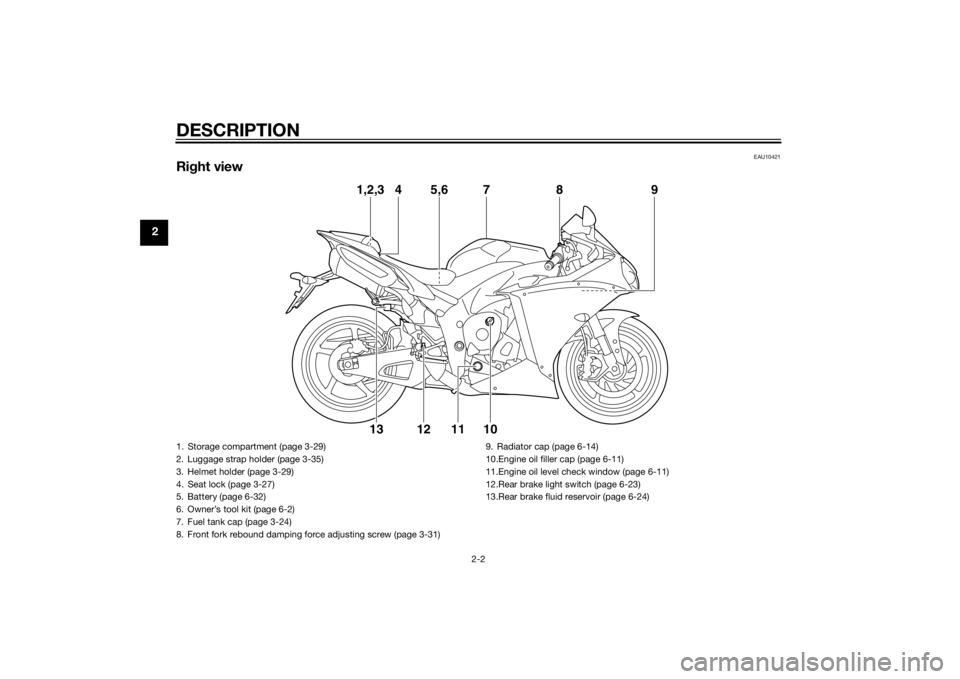
DESCRIPTION
2-2
2
EAU10421
Right view
1,2,3
4
9
5,6
7
8
10
11
12
13
1. Storage compartment (page 3-29)
2. Luggage strap holder (page 3-35)
3. Helmet holder (page 3-29)
4. Seat lock (page 3-27)
5. Battery (page 6-32)
6. Owner’s tool kit (page 6-2)
7. Fuel tank cap (page 3-24)
8. Front fork rebound damping force adjusting screw (page 3-31) 9. Radiator cap (page 6-14)
10.Engine oil filler cap (page 6-11)
11.Engine oil level check window (page 6-11)
12.Rear brake light switch (page 6-23)
13.Rear brake fluid reservoir (page 6-24)U2SGE0E0.book Page 2 Wednesday, June 12, 2013 1:15 PM
Page 15 of 114
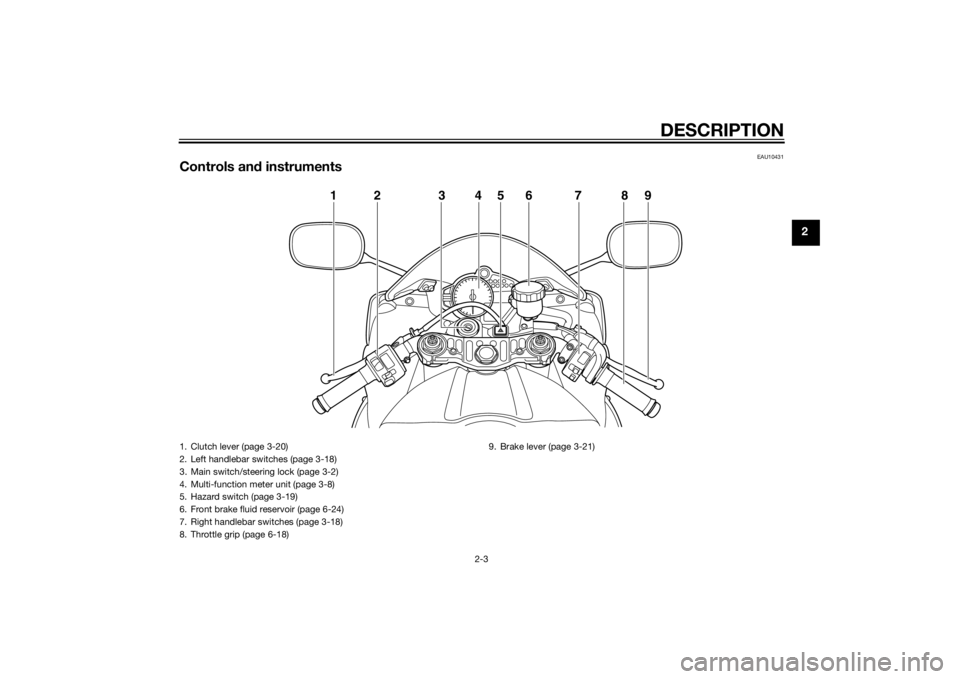
DESCRIPTION
2-3
2
EAU10431
Controls and instruments
12 3 6
5789
4
1. Clutch lever (page 3-20)
2. Left handlebar switches (page 3-18)
3. Main switch/steering lock (page 3-2)
4. Multi-function meter unit (page 3-8)
5. Hazard switch (page 3-19)
6. Front brake fluid reservoir (page 6-24)
7. Right handlebar switches (page 3-18)
8. Throttle grip (page 6-18) 9. Brake lever (page 3-21)
U2SGE0E0.book Page 3 Wednesday, June 12, 2013 1:15 PM
Page 17 of 114
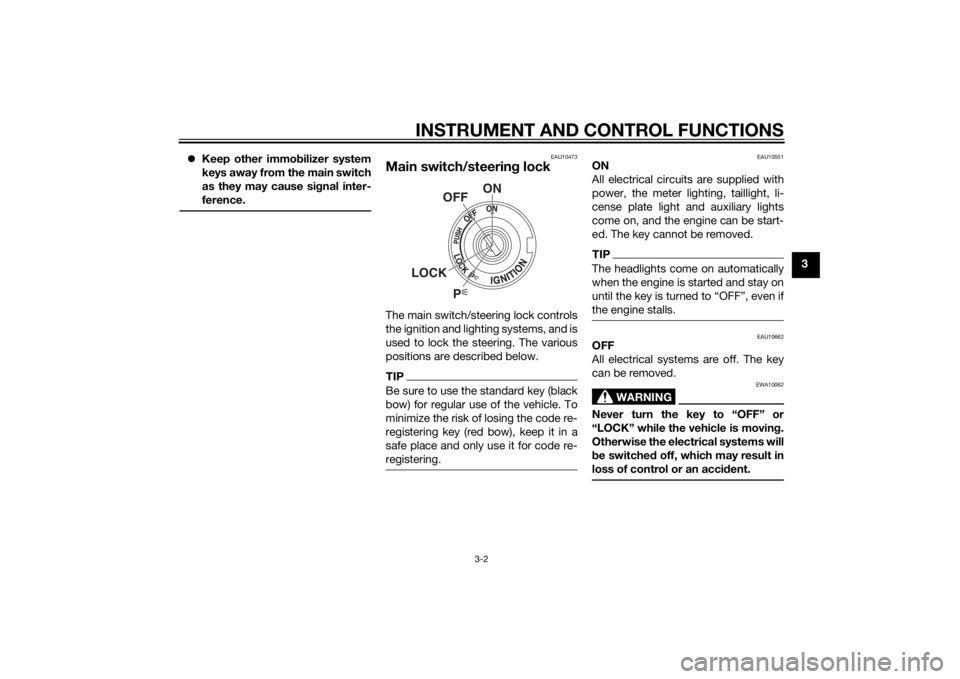
INSTRUMENT AND CONTROL FUNCTIONS
3-2
3
Keep other immo bilizer system
keys away from the main switch
as they may cause si gnal inter-
ference.
EAU10473
Main switch/steerin g lockThe main switch/steering lock controls
the ignition and lighting systems, and is
used to lock the steering. The various
positions are described below.TIPBe sure to use the standard key (black
bow) for regular use of the vehicle. To
minimize the risk of losing the code re-
registering key (red bow), keep it in a
safe place and only use it for code re-
registering.
EAU10551
ON
All electrical circuits are supplied with
power, the meter lighting, taillight, li-
cense plate light and auxiliary lights
come on, and the engine can be start-
ed. The key cannot be removed.TIPThe headlights come on automatically
when the engine is started and stay on
until the key is turned to “OFF”, even if
the engine stalls.
EAU10662
OFF
All electrical systems are off. The key
can be removed.
WARNING
EWA10062
Never turn the key to “OFF” or
“LOCK” while the vehicle is movin g.
Otherwise the electrical systems will
b e switche d off, which may result in
loss of control or an acci dent.
P
ON
OFF
LOCK
U2SGE0E0.book Page 2 Wednesday, June 12, 2013 1:15 PM
Page 18 of 114
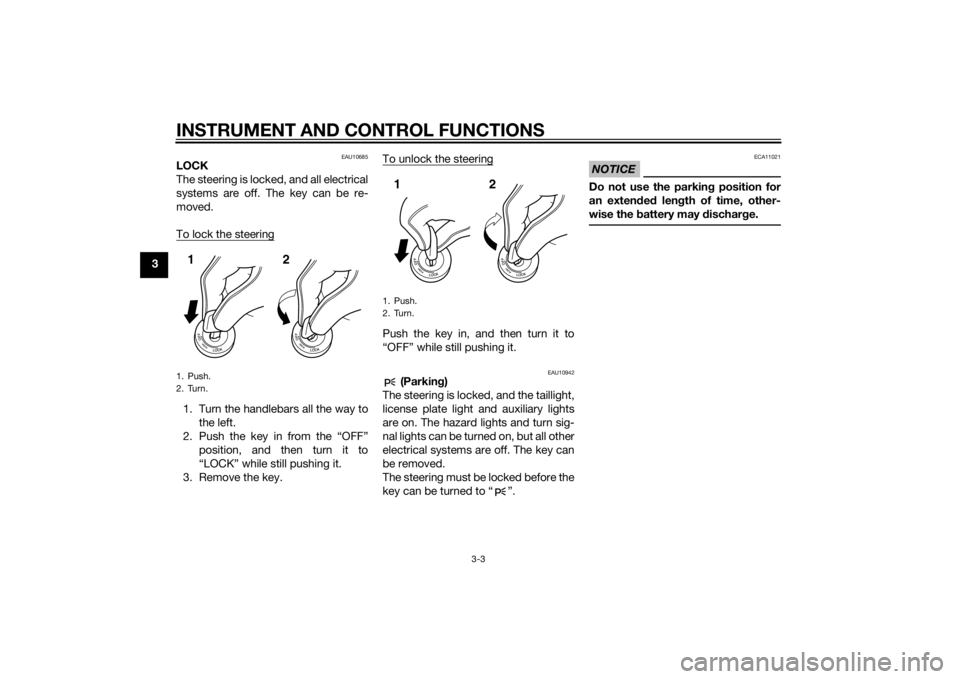
INSTRUMENT AND CONTROL FUNCTIONS
3-3
3
EAU10685
LOCK
The steering is locked, and all electrical
systems are off. The key can be re-
moved.
To lock the steering1. Turn the handlebars all the way tothe left.
2. Push the key in from the “OFF” position, and then turn it to
“LOCK” while still pushing it.
3. Remove the key. To unlock the steering
Push the key in, and then turn it to
“OFF” while still pushing it.
EAU10942
(Parkin
g)
The steering is locked, and the taillight,
license plate light and auxiliary lights
are on. The hazard lights and turn sig-
nal lights can be turned on, but all other
electrical systems are off. The key can
be removed.
The steering must be locked before the
key can be turned to “ ”.
NOTICE
ECA11021
Do not use the parkin g position for
an exten ded len gth of time, other-
wise the battery may d ischarge.
1. Push.
2. Turn.12
1. Push.
2. Turn.12
U2SGE0E0.book Page 3 Wednesday, June 12, 2013 1:15 PM
Page 23 of 114
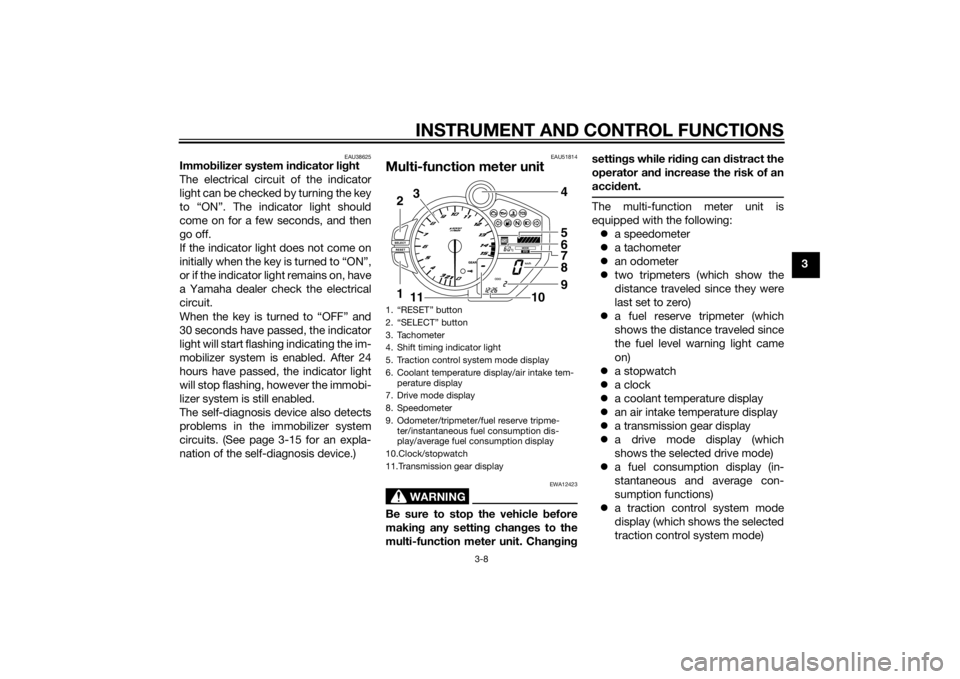
INSTRUMENT AND CONTROL FUNCTIONS
3-8
3
EAU38625
Immobilizer system in dicator li ght
The electrical circuit of the indicator
light can be checked by turning the key
to “ON”. The indicator light should
come on for a few seconds, and then
go off.
If the indicator light does not come on
initially when the key is turned to “ON”,
or if the indicator light remains on, have
a Yamaha dealer check the electrical
circuit.
When the key is turned to “OFF” and
30 seconds have passed, the indicator
light will start flashing indicating the im-
mobilizer system is enabled. After 24
hours have passed, the indicator light
will stop flashing, however the immobi-
lizer system is still enabled.
The self-diagnosis device also detects
problems in the immobilizer system
circuits. (See page 3-15 for an expla-
nation of the self-diagnosis device.)
EAU51814
Multi-function meter unit
WARNING
EWA12423
Be sure to stop the vehicle before
makin g any settin g chan ges to the
multi-function meter unit. Chan gin g settin
gs while ri din g can d istract the
operator an d increase the risk of an
acci dent.
The multi-function meter unit is
equipped with the following:
a speedometer
a tachometer
an odometer
two tripmeters (which show the
distance traveled since they were
last set to zero)
a fuel reserve tripmeter (which
shows the distance traveled since
the fuel level warning light came
on)
a stopwatch
a clock
a coolant temperature display
an air intake temperature display
a transmission gear display
a drive mode display (which
shows the selected drive mode)
a fuel consumption display (in-
stantaneous and average con-
sumption functions)
a traction control system mode
display (which shows the selected
traction control system mode)
1. “RESET” button
2. “SELECT” button
3. Tachometer
4. Shift timing indicator light
5. Traction control system mode display
6. Coolant temperature display/air intake tem-
perature display
7. Drive mode display
8. Speedometer
9. Odometer/tripmeter/fuel reserve tripme- ter/instantaneous fuel consumption dis-
play/average fuel consumption display
10.Clock/stopwatch
11.Transmission gear display2
1 3
4
5
6
7
8
9
10
11
U2SGE0E0.book Page 8 Wednesday, June 12, 2013 1:15 PM
Page 24 of 114
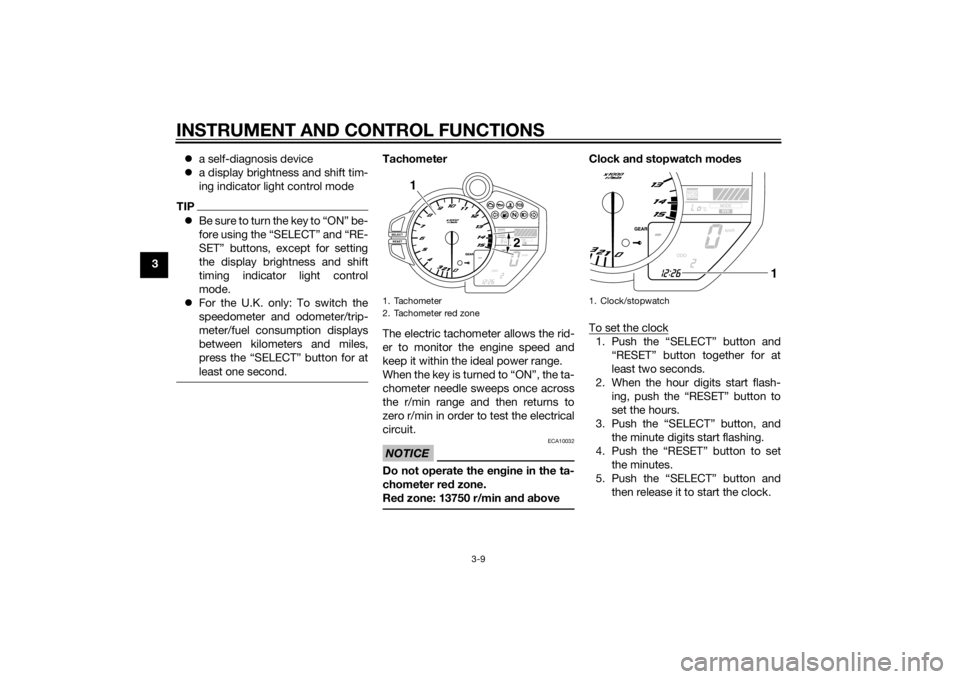
INSTRUMENT AND CONTROL FUNCTIONS
3-9
3
a self-diagnosis device
a display brightness and shift tim-
ing indicator light control mode
TIPBe sure to turn the key to “ON” be-
fore using the “SELECT” and “RE-
SET” buttons, except for setting
the display brightness and shift
timing indicator light control
mode.
For the U.K. only: To switch the
speedometer and odometer/trip-
meter/fuel consumption displays
between kilometers and miles,
press the “SELECT” button for at
least one second.
Tachometer
The electric tachometer allows the rid-
er to monitor the engine speed and
keep it within the ideal power range.
When the key is turned to “ON”, the ta-
chometer needle sweeps once across
the r/min range and then returns to
zero r/min in order to test the electrical
circuit.NOTICE
ECA10032
Do not operate the en gine in the ta-
chometer red zone.
Re d zone: 13750 r/min an d a bove
Clock an d stopwatch mo des
To set the clock1. Push the “SELECT” button and “RESET” button together for at
least two seconds.
2. When the hour digits start flash- ing, push the “RESET” button to
set the hours.
3. Push the “SELECT” button, and the minute digits start flashing.
4. Push the “RESET” button to set the minutes.
5. Push the “SELECT” button and then release it to start the clock.
1. Tachometer
2. Tachometer red zone
2
1
1. Clock/stopwatch
1
U2SGE0E0.book Page 9 Wednesday, June 12, 2013 1:15 PM
Page 25 of 114
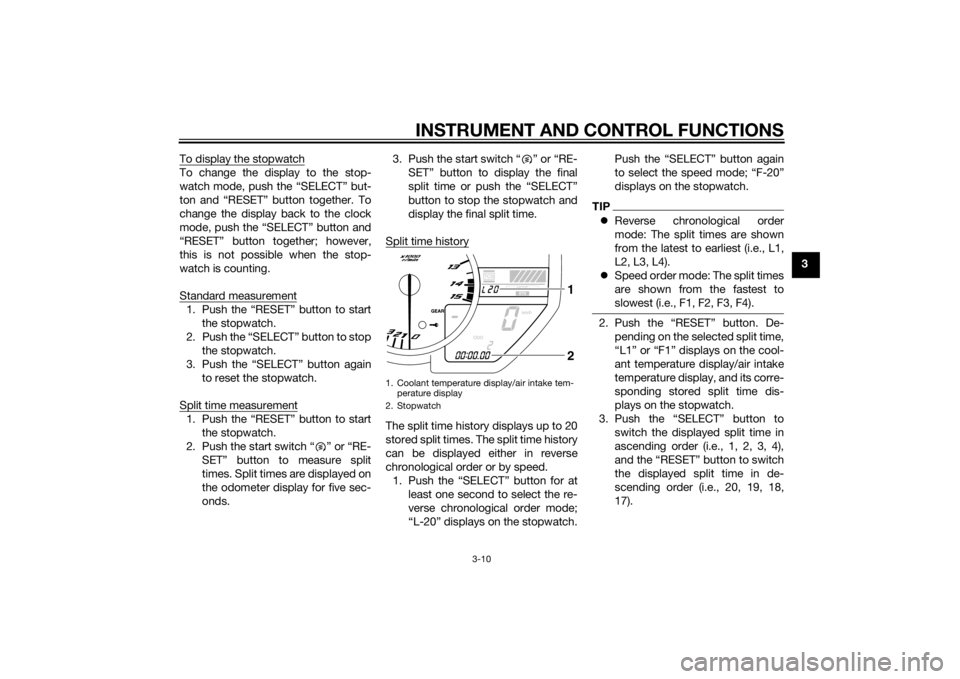
INSTRUMENT AND CONTROL FUNCTIONS
3-10
3
To display the stopwatch
To change the display to the stop-
watch mode, push the “SELECT” but-
ton and “RESET” button together. To
change the display back to the clock
mode, push the “SELECT” button and
“RESET” button together; however,
this is not possible when the stop-
watch is counting.
Standard measurement1. Push the “RESET” button to start
the stopwatch.
2. Push the “SELECT” button to stop the stopwatch.
3. Push the “SELECT” button again to reset the stopwatch.
Split time measurement1. Push the “RESET” button to start the stopwatch.
2. Push the start switch “ ” or “RE- SET” button to measure split
times. Split times are displayed on
the odometer display for five sec-
onds. 3. Push the start switch “ ” or “RE-
SET” button to display the final
split time or push the “SELECT”
button to stop the stopwatch and
display the final split time.
Split time history
The split time history displays up to 20
stored split times. The split time history
can be displayed either in reverse
chronological order or by speed. 1. Push the “SELECT” button for at least one second to select the re-
verse chronological order mode;
“L-20” displays on the stopwatch. Push the “SELECT” button again
to select the speed mode; “F-20”
displays on the stopwatch.
TIP
Reverse chronological order
mode: The split times are shown
from the latest to earliest (i.e., L1,
L2, L3, L4).
Speed order mode: The split times
are shown from the fastest to
slowest (i.e., F1, F2, F3, F4).2. Push the “RESET” button. De-
pending on the selected split time,
“L1” or “F1” displays on the cool-
ant temperature display/air intake
temperature display, and its corre-
sponding stored split time dis-
plays on the stopwatch.
3. Push the “SELECT” button to switch the displayed split time in
ascending order (i.e., 1, 2, 3, 4),
and the “RESET” button to switch
the displayed split time in de-
scending order (i.e., 20, 19, 18,
17).
1. Coolant temperature display/air intake tem-perature display
2. Stopwatch
21
U2SGE0E0.book Page 10 Wednesday, June 12, 2013 1:15 PM
Page 39 of 114
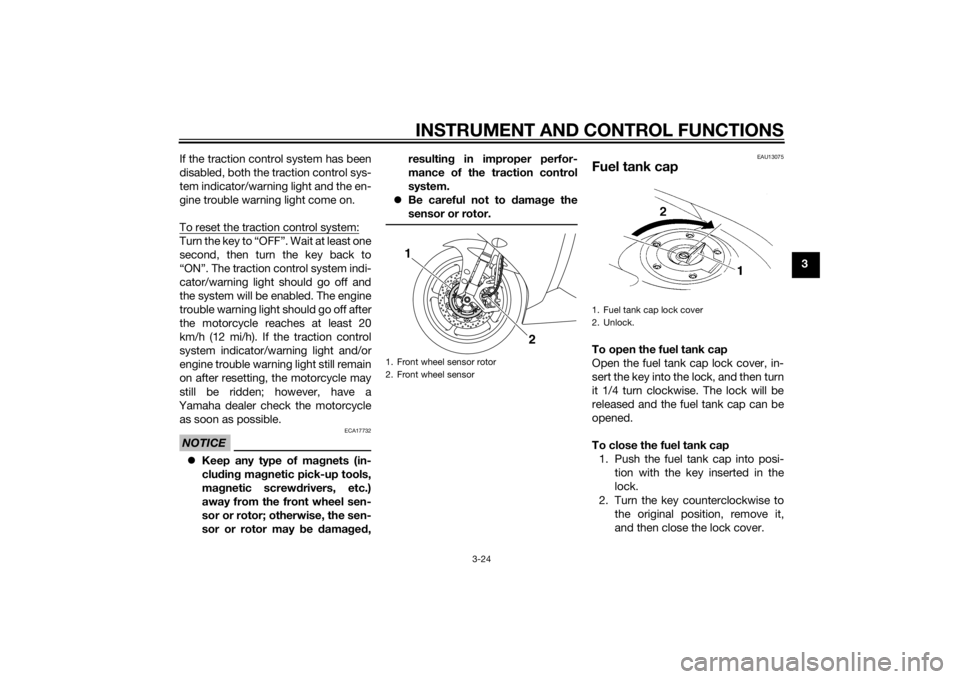
INSTRUMENT AND CONTROL FUNCTIONS
3-24
3
If the traction control system has been
disabled, both the traction control sys-
tem indicator/warning light and the en-
gine trouble warning light come on.
To reset the traction control system:
Turn the key to “OFF”. Wait at least one
second, then turn the key back to
“ON”. The traction control system indi-
cator/warning light should go off and
the system will be enabled. The engine
trouble warning light should go off after
the motorcycle reaches at least 20
km/h (12 mi/h). If the traction control
system indicator/warning light and/or
engine trouble warning light still remain
on after resetting, the motorcycle may
still be ridden; however, have a
Yamaha dealer check the motorcycle as soon as possible.NOTICE
ECA17732
Keep any type of mag nets (in-
clu din g ma gnetic pick-up tools,
ma gnetic screw drivers, etc.)
away from the front wheel sen-
sor or rotor; otherwise, the sen-
sor or rotor may be damag ed , resultin
g in improper perfor-
mance of the traction control
system.
Be careful not to d amage the
sensor or rotor.
EAU13075
Fuel tank capTo open the fuel tank cap
Open the fuel tank cap lock cover, in-
sert the key into the lock, and then turn
it 1/4 turn clockwise. The lock will be
released and the fuel tank cap can be
opened.
To close the fuel tank cap 1. Push the fuel tank cap into posi- tion with the key inserted in the
lock.
2. Turn the key counterclockwise to the original position, remove it,
and then close the lock cover.
1. Front wheel sensor rotor
2. Front wheel sensor
2
1
1. Fuel tank cap lock cover
2. Unlock.
U2SGE0E0.book Page 24 Wednesday, June 12, 2013 1:15 PM
Page 40 of 114
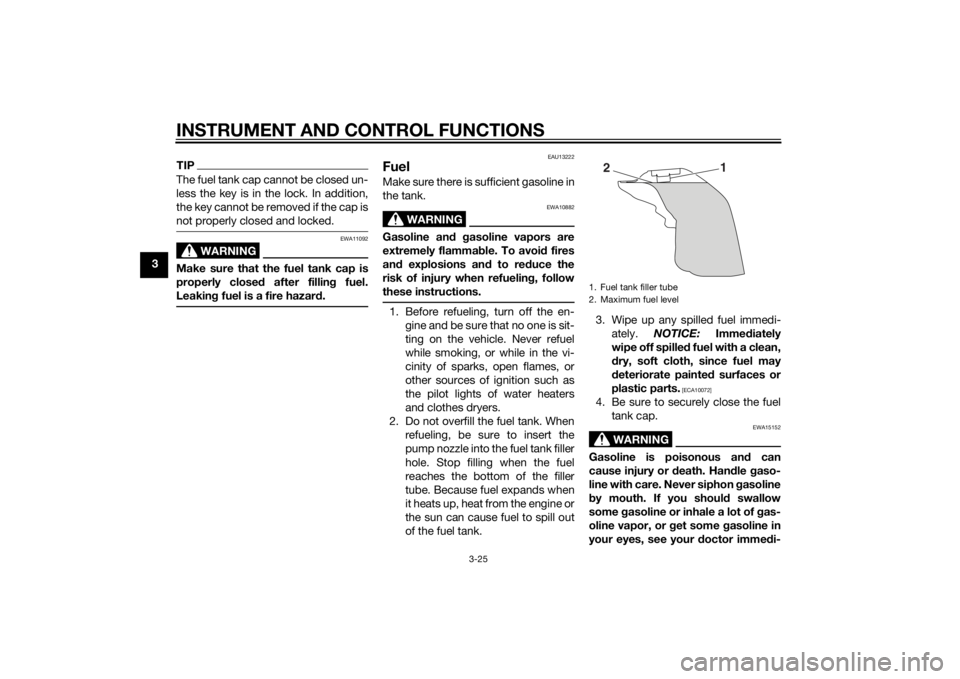
INSTRUMENT AND CONTROL FUNCTIONS
3-25
3
TIPThe fuel tank cap cannot be closed un-
less the key is in the lock. In addition,
the key cannot be removed if the cap is
not properly closed and locked.
WARNING
EWA11092
Make sure that the fuel tank cap is
properly closed after fillin g fuel.
Leakin g fuel is a fire hazar d.
EAU13222
FuelMake sure there is sufficient gasoline in
the tank.
WARNING
EWA10882
Gasoline an d g asoline vapors are
extremely flamma ble. To avoi d fires
an d explosions an d to re duce the
risk of injury when refuelin g, follow
these instructions.1. Before refueling, turn off the en- gine and be sure that no one is sit-
ting on the vehicle. Never refuel
while smoking, or while in the vi-
cinity of sparks, open flames, or
other sources of ignition such as
the pilot lights of water heaters
and clothes dryers.
2. Do not overfill the fuel tank. When refueling, be sure to insert the
pump nozzle into the fuel tank filler
hole. Stop filling when the fuel
reaches the bottom of the filler
tube. Because fuel expands when
it heats up, heat from the engine or
the sun can cause fuel to spill out
of the fuel tank. 3. Wipe up any spilled fuel immedi-
ately. NOTICE: Immediately
wipe off spille d fuel with a clean,
d ry, soft cloth, since fuel may
d eteriorate painted surfaces or
plastic parts.
[ECA10072]
4. Be sure to securely close the fuel tank cap.
WARNING
EWA15152
Gasoline is poisonous an d can
cause injury or death. Han dle gaso-
line with care. Never siphon gasoline
b y mouth. If you shoul d swallow
some gasoline or inhale a lot of g as-
oline vapor, or g et some gasoline in
your eyes, see your doctor imme di-1. Fuel tank filler tube
2. Maximum fuel level
2 1
U2SGE0E0.book Page 25 Wednesday, June 12, 2013 1:15 PM